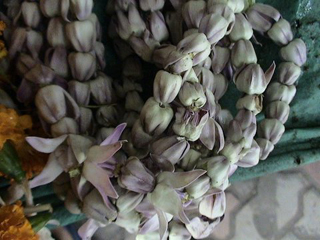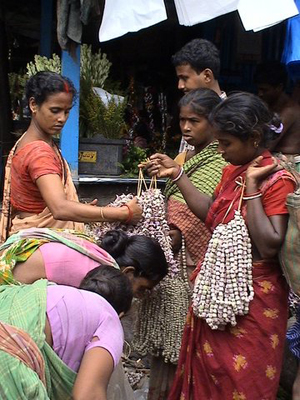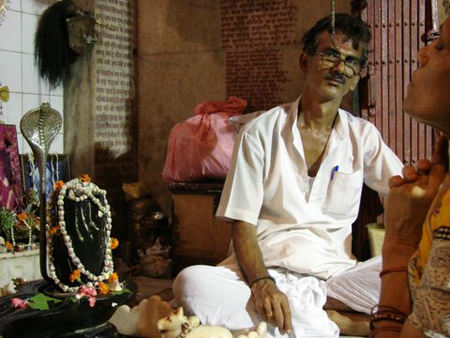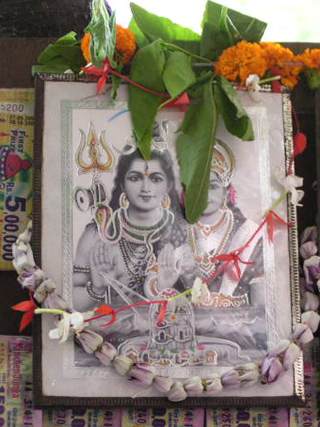Human Flower Project
Milkweed Pearls for Lord Shiva
Sandy Ao shows how Kolkata honors the great destroyer deity—with blooms from an invasive plant.

Garlands of Calotropis gigantea, Giant milkweed flowers
Photo: Sandy Ao
“The gods would not refuse even the trivial erukku for worship,” declared the Purananuru 2000 years ago.
Trivial? Perhaps “lowly” would be a better translation. Erukku is the Tamil name for Calotropis gigantea, growing now as it must have back then— as “a common wasteland weed” across South Asia. Also known as swallowwort, giant milkweed and (by its flatterers) crown flower, this poisonous plant is sacred to Hinduism’s most fearsome deity – Shiva.
Since Monday is Shiva’s special day (as are the 13th night of the waxing moon and the 14th day), there seemed no time like the present to convey a beautiful set of Calotropis pictures Sandy Ao gathered around her home city, Kolkata, India.
 Women selling calotropis garlands
Women selling calotropis garlands
Mullickghat market, Kolkata
Photo: Sandy Ao
Sandy writes, “There are no specific seasons for Calotropis and Datura,” another flower sacred to Shiva – and also a poisonous one. “Mainly these are wild flowers, not cultivated like marigold and tuberose. They are used through out the year – especially Calotropis. Wherever there are Shiva’s pictures, symbols (the Lingam) or statues, we will see a garland of Calotropis around them.” Sandy also makes note, after many visits to the big Mullickghat flower market, “I see more women selling Datura and Calotropis garlands than the men.” Threaded into strands, the calotropis flowers look like lavender pearls.
Shiva appears throughout Kolkata in many forms. He blows a conch shell on kitschy calendars and poses with his trident and, sometimes, snakes coiling about his blue neck at the lotto stand.
Startling to rheumy western eyes, Lord Shiva is also embodied in stone phalluses – the “lingam” Sandy referred to – that symbolize his chthonic, reproductive powers. We would suppose these sacred stones are ”erected” in Shiva’s many hundreds of temples across India, but as Sandy‘s photographs show, they also appear beside busy thoroughfares, usually under banyan trees, and at what seem to be streetside shrines. In nearly all of Sandy’s photographs, one can see pearly strings of calotropis flowers honoring the great god.

Devotee prays at a Lingam, representing Shiva, at a Kolkata street shrine
Photo: Sandy Ao
She spoke with a number of flower sellers about just how calotropis, datura and magnolia (also sacred to Shiva, and lots more expensive than the other blossoms) are used with bael leaves in devotions: “I was told that during the offering of flowers to Lord Shiva, the bael leaf will be placed on top of Lord Shiva’s head/Lingam. Datura /Magnolia will be on Lord Shiva’s ears. If it’s a lingam, these flowers will be placed above the bael leaf and kept on top of the Lingam. On the floor in front of Lord Shiva / Lingam, first a bael leaf will be placed; only then will other varieties of flowers be spread around the ground.
“And Calotropis will always come as a garland for Lord Shiva.”
 Image of Lord Shiva
Image of Lord Shiva
decorated with marigolds, bael leaf, and calotropis buds
Photo: Sandy Ao
Shiva’s name means “auspiciousness, welfare” though he wields the power of destruction. “He represents darkness and is said to be the ‘angry god.’ However, according to Hinduism, creation follows destruction.” (Picasso called painting “a sum of destructions,” didn’t he?) Just so, we learn, “Shiva is also regarded as a reproductive power, which restores what has been dissolved.”
Fitting, that that this god of fertility is honored by what some might also call an “invasive plant.”
Sandy tells us that in Hyderabad, “Calotropis grows wildly and plentifully, especially in the unattended compounds. Whereas, in Bengal (Kolkata), people collect the buds before they are fully bloomed and turn them into garlands for Shiva.” Lowly, perhaps, but much in demand.
“If one desires to worship God externally,” the old poem says, “let him just take the flowers which have fallen from the tree and worship the Supreme Siva here on some external symbol, just as He is worshipped in the heart.” The heart that bursts open like a pod of gossamer and seed.


I was at Wave Hill, in the Bronx, New York just last Thursday, Sept 27. And there I saw Calotropis gigantea in flower. It is a wonderful as your write-up depicts.